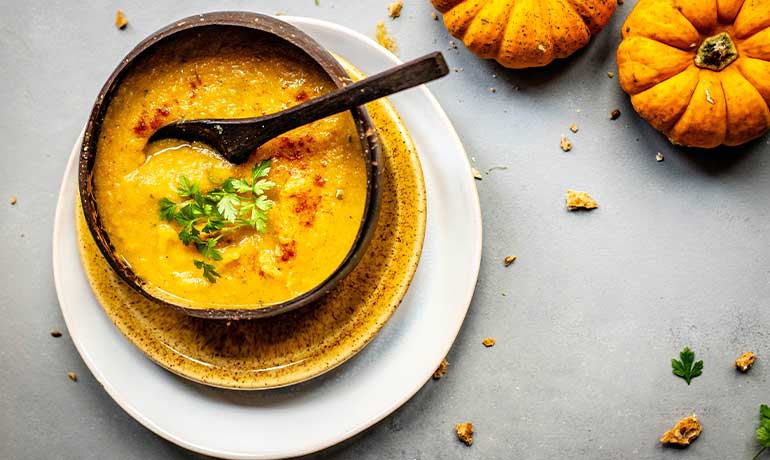
Fall Season - Best Ayurvedic Food Recipes for Vata Dosha
Ayurveda views taste as an essential therapeutic tool. While each of the six tastes has a vital role to play, the perfect combination of tastes can vary wildly from one person to the next.
The Vata Supportive And Aggravating Tastes:

Vata Season 6 Tastes
When it comes to balancing Vata, the sweet, sour, and salty tastes tend to be the most supportive, while too much of the pungent, bitter, and astringent tastes can be aggravating.
The Sweet Taste nourishes all of the tissues in the body and is both replenishing and rejuvenating, can help to counter vata’s tendency toward constipation, also helps to calm neuromuscular Vata imbalances. It should be minimized when there is excess mucus, excess heaviness, excess fat, and excess sleep
The Sour Taste is digestive and supports the appetite, overall metabolism, proper elimination, and also specifically helps to eliminate gas. It has a unique capacity to clear dryness and to expel excess Vata.
The Salty Taste supports appetite, digestion, absorption, assimilation, elimination, and is anti-flatulent as well. It moistens the body and helps to maintain the water-electrolyte balance, which is easily disrupted by excess Vata.
The Pungent Taste aggravates vata because as it is extremely drying
The Bitter Taste dries the tissues and drains moisture from the body
The Astringent Taste is taxing for vata’s delicate digestion and it has a specific affinity for the colon—the seat of Vata – and its qualities are inherently Vata provoking.
Vata Pacifiers or Stabilizers:
Due to Vata being cold and dry, warm nourishing foods are good for stabilizing Vata. A few simple Vata pacifying remedies,
- Drinking hot water,
- Warm sesame oil massage, and
- Adding some warming spices to your food.
Foods To Be Chosen To Re-establish And Maintain Vata Balance:
- Substances that have the Sweet Taste: Most sweet fruits are acceptable. Beets, carrots (cooked), cucumber, olives, sweet potatoes, corn, rice, wheat, lentils (red), mung beans, navy beans, tofu, urad dal, almonds, cashews, coconut, pumpkin seeds, ghee, milk, eggs, beef, buffalo, pork, salmon, Sweeteners,
- Sweet and/or Warming Herbs and Spices: Allspice Anise, Asafoetida (Hing), Basil, Bay leaf, Black Pepper (sparingly), Caraway, Cardamom, Cilantro (green coriander), Clove, Cumin, Cinnamon, Fennel Ginger, Juniper Berries, Liquorice, root Mace, Marjoram, Mustard, Nutmeg, Orange Peel, Oregano, Sage, Tarragon, Thyme.
Emphasizing, the sweet taste does NOT require us to eat large amounts of refined sugar or sugary-sweet foods. In fact, doing so tends to exacerbate vata’s tendency to over-exert and then crash. Naturally sweet foods tend to be grounding, nourishing, strength-building, and satisfying.
- Prefer fresh nuts that are heavy and oily as opposed to dry salty snacks.
- Cold foods and iced drinks and drinks with high caffeine disturb Vata. So drink room temperature water instead of cold or ice water and drinks.
- Avoid unripe fruits (as they are astringent), dry foods, bitter tastes, candies, as they disturb Vata.
Simple vegetable soup with Vata Spice Mix or curry powder balances your Vata and is mildly cleansing as well as healing, providing natural vitamins, minerals, and proteins, to nourish your body.
Vata Spice Mix To Keep Your Vata Balanced
A certain ratio of the spices is beneficial in relieving colic, spasm, and gas. It aids in the downward movement of Vata.
Ingredients:
- 2 tablespoon of Fennel Seeds
- 1 tablespoon of Cumin Seeds
- 1 tablespoon of Coriander Seeds
- 1 tablespoon of ground Turmeric
- 1 teaspoon of Asafoetida
- 2 teaspoon of ginger powder
How to make it:
- Gentle dry roast the spices
- Grind the toasted spices until it becomes a smooth and even grind powder
- Pour the mixture into an airtight container and use as needed.
How to use it:
Use it for cooking, sauté with organic ghee until the aroma is released, add to your cooking (vegetables, lentils, soups, rice, etc). Add 1 tsp of the spice mix per serving.
Below are the few Recipes for Vata Imbalance (Fall Season)
Butternut Squash
Vata Calming Soups

VATA CALMING SOUPS – HOW TO PREPARE EASY & HEALTHY BUTTERNUT SQUASH SOUP RECIPE
Ingredients:
- 1 medium butternut squash, peeled, seeded, and cut into 1-inch pieces
- 1 cup red pumpkin peeled, seeded, and cut into 1-inch pieces
- 1-inch piece fresh ginger washed and finely chopped
- 1 teaspoon (tsp.) cinnamon
- 1teaspoon Vata spice mix
- 3 cups water and 1 cup coconut milk
- Salt and pepper to taste
- Nutmeg for garnish
- 2 tbsp. ghee
How To Prepare (Method):
- Boil or steam the butternut squash and pumpkin.
- Now, add the water or coconut milk and mix. Keep aside.
- Warm the ghee. Add the cumin, ginger, Vata spice mix powder, clove, and cinnamon in it, till an enticing aroma fills the room.
- Add the spices to the original mix.
- Mash the mixture with a masher.
- Garnish with nutmeg.
- Serve hot.
You can substitute butternut squash for any other winter squash that you like. You may change the character of the soup by adding cilantro or parsley, and cream instead of coconut milk.
Mixed Vegetable Soup

Vata Calming Soups – How To Prepare Easy, Simple & Healthy Mix Vegetable Soup Recipe
Ingredients:
- 2 celery stalks with leaves, chopped
- 2 carrots, scrubbed and chopped
- 2 small potatoes /yams (with skin) cubed
- 2-3 cups fresh greens (spinach/kale/collards /chard)
- 1 small red beet, peeled and chopped
- 1 cup cauliflower chopped
- 1 cup green cabbage chopped
- ½ bunch fresh cilantro washed, chopped
- 1 cup of fresh tofu cubed
- 1 small onion finely chopped (optional)
- 1 clove garlic (optional)
- 2 tsp. olive oil
- ½ tsp. Vata Spice Mix (or curry powder)
- ½ tsp. grated ginger
- Salt to taste (½ tsp.)
How To Prepare (Method):
- In a medium-size pot, heat the olive oil over medium heat.
- Add garlic and onion, stirring frequently for 4-5 minutes or until it is a golden color. Add Vata Spice Mix (or curry powder) and ginger.
- Stir in the vegetables, except for the greens (save the cilantro until the last step(, and cook for 2-3 minutes.
- Add 4-5 cups of boiling water, reduce to a simmer, cover and cook for 15 minutes.
- Add the greens and the tofu and cook for 5 minutes.
- Add salt to taste and sprinkle the soup with cilantro.
This truly is medicine in a bowl for this very dry yet exceptionally beautiful Vata Season (fall-early winter).
About the Author
Radhika Rajalakshmi
See all articles

Contact Us


















- Copyright © 2024. All rights reserved | Developed by Arokia IT LLC |
- Privacy Policy |
- Terms Of Service |
- Shipping & Returns |





